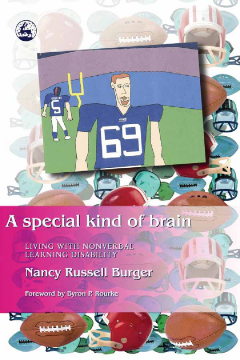
Additional Information
Book Details
Abstract
Sharing the experience of bringing up a child with nonverbal learning disability (NLD), this warm and accessible book offers advice on subjects ranging across diagnosis and therapy, children's interaction with each other, suitable activities for a child with NLD and how to discuss NLD with children. An essential guide, this book will reassure, advise and inform parents and professionals who work with children with NLD.
Nancy Russell Burger is a freelance writer whose nine-year-old son, Jimmy, was diagnosed with NLD at the age of four. She lives in Redding, Connecticut with her husband David, Jimmy and seven-year-old daughter Shawn.
A nicely-presented guide aimed at parents and social care staff, both of whom may need some informed and practical guidance on how to work with, support and interact constructively with children with nonverbal learning disability (NLD).
Care and Health Magazine
Table of Contents
| Section Title | Page | Action | Price |
|---|---|---|---|
| Acknowledgements v | |||
| List of Tables and Figures ix | |||
| List of Diagrams X | |||
| Introduction 1 | |||
| PART I: PONDS, PROTEIN AND THE POOR 7 | |||
| Chapter 1: Aquaculture in Bangladesh 9 | |||
| The setting: rural Bangladesh 9 | |||
| Fisheries in Bangladesh 20 | |||
| Aquaculture 23 | |||
| The region 27 | |||
| The study methodology 28 | |||
| Organization of the material 30 | |||
| Chapter 2: Markets, entrepreneurs and intervention 33 | |||
| Introduction: the policy context 33 | |||
| Aquaculture: state, market and community 35 | |||
| Rural markets 36 | |||
| Aquaculture markets - 41 | |||
| Entrepreneurship and innovation 43 | |||
| Intervention issues ' 46 | |||
| PART II: THE FISH TRADING NETWORK-TRAINS; | |||
| BUSES AND RICKSHAWS 51 | |||
| Introduction: an overview of the trading system 53 | |||
| Chapter 3: Finding the silver seed 55 | |||
| Wild hatchling collection 55 | |||
| Hatchery production 60 | |||
| Fingerling production 64 | |||
| Chapter 4: Wholesalers at the station 71 | |||
| The station market 71 | |||
| Chapter 5: Into the rural hinterland 77 | |||
| Fingerling traders and transportation 77 | |||
| Management of food fish ponds 86 | |||
| Chapter 6: Netting the catch 93 | |||
| The decline of traditional fisherfolk 93 | |||
| Food fish markets and traders 101 | |||
| PART III: POVERTY, MARKETS AND PROJECTS 113 | |||
| Chapter 7: Risky transactions 115 | |||
| The power of knowledge 115 | |||
| Risk management 117 | |||
| Credit, prices and profits 120 | |||
| Interlocked markets 124 | |||
| Chapter 8: Social preconditions of markets-the test | |||
| case of cultured fish 127 | |||
| Aquaculture and agrarian structure 127 | |||
| Markets, trust and morality 131 | |||
| The absence of formal law 136 | |||
| Winners and losers 143 | |||
| Chapter 9: Improving opportunities for the poor 147 | |||
| Possibilities considered 147 | |||
| 'Off the page and into the pond' 153 | |||
| 'Indigenizing' extension: the extension trader experiment 154 | |||
| Appendices | |||
| 1 Wild hatchling collection 167 | |||
| 2 The hypophysation process 168 | |||
| 3 Techniques of fingerling transportation 169 | |||
| 4 Water quality in the carrying vessels 173 | |||
| 5 Station trading data (seasonal distribution by species) 176 | |||
| 6 Price data 181 | |||
| Glossary 185 | |||
| Specialist terms 187 | |||
| Bibliography 189 | |||
| Index 195 |
